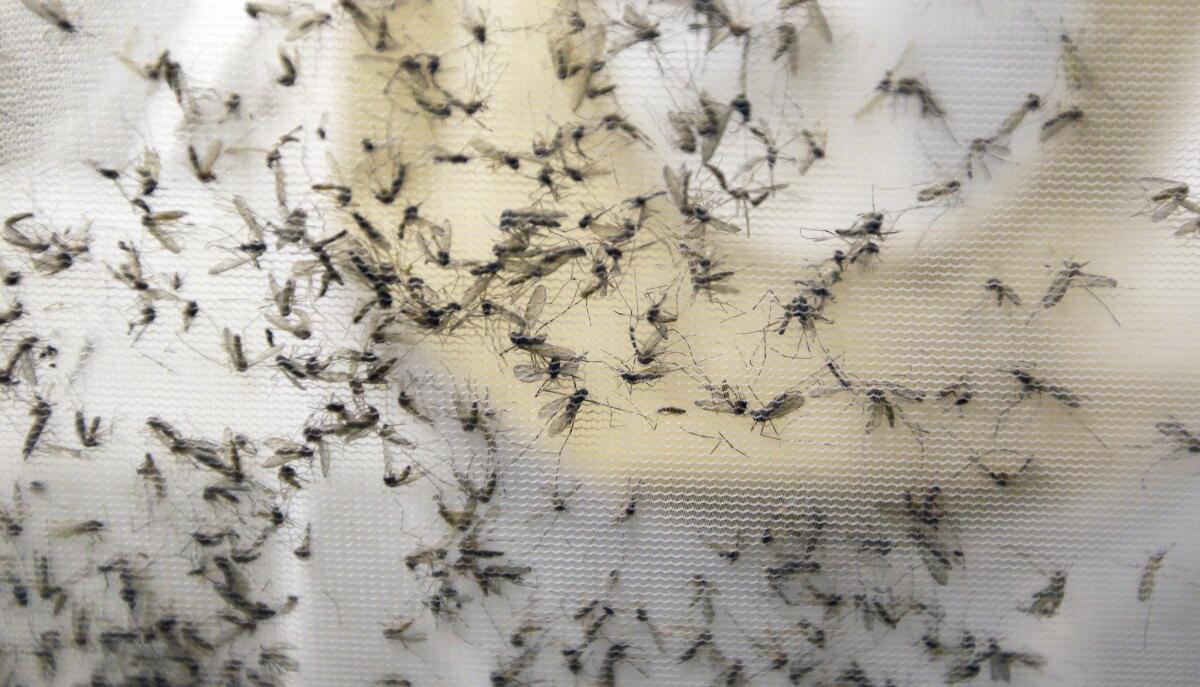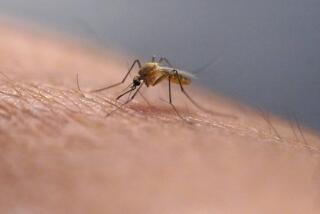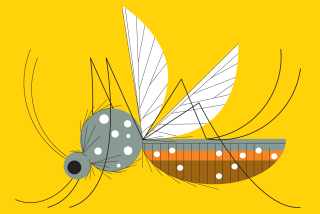Op-Ed: Humans are the not-so-innocent bystanders in the Zika mosquito’s proliferation

- Share via
Aedes aegypti mosquitoes, which carry the Zika virus, are kind of like dogs. OK, the analogy isn’t perfect. Dogs don’t fly, and they don’t suck blood, and they don’t lay eggs. But like our canine pals, Aedes aegypti started out wild and got domesticated.
With dogs, it took thousands of years. With these mosquitoes, the time frame has been much shorter. We humans happily joined in the process that changed wolves into dogs. With Aedes aegypti, we’ve been not-so-innocent and increasingly unhappy bystanders.
Originally, these mosquitoes cavorted in African treetops, feeding on monkeys and seeking pristine rain-filled tree cavities in which to lay their eggs. They also happened to have the potential to pick up and transmit particular viruses harmful to humans. That didn’t matter much until urbanization brought people closer to forests. It turned out that some Aedes aegypti had genes that allowed them to thrive outside the jungle and away from treetops. They could lay eggs wherever a castoff lid of a plastic water bottle caught a splash of rainwater. They could bite the nearest toddler instead of searching for a monkey. They had offspring that could do the same things, and natural selection did its work.
Eventually, a new kind of Aedes aegypti genetically diverged from its ancestors through evolution. The new breed is, among other adaptations, lighter in color (the better to hang out with humans, who have a harder time seeing and swatting them) and active during the day (not at dawn or dusk like most mosquito varieties), and they’d just as soon be indoors as out. They have happily traveled with people on trade routes to the Americas, Asia and beyond, and now they wouldn’t go back to their old lifestyle even if they could. Aedes aegypti prefer human blood for their sustenance and human trash for their nurseries.
The point is that domestication isn’t always something we humans do to other living things on purpose. It’s also something that animals do to themselves. Evolution happens all the time, to all living things, not just to the species we choose. We may not be responsible for this mosquito’s domestication, but we are for its proliferation. The spread of human-generated garbage in the last few decades, especially long-lived plastic and rubber, has created a boom in Aedes aegypti breeding grounds. Particularly in the developing world, populations of these mosquitoes are at an all-time high, making the consequences of their evolution especially pressing.
Mosquitoes change in response to chemicals with astonishing rapidity... We won’t spray our way out of this insect-borne disease.
At the moment, those consequences are serious outbreaks of Zika, with Aedes aegypti as the virus’ primary vector. Zika may lead to brain damage in the babies of infected mothers and to an autoimmune disorder in some adults. So far, the 691 cases reported in the U.S. all appear to have their origins from travel abroad. But the potential for Zika’s spread here remains: Aedes aegypti mosquitoes are found throughout the South and the Southwest, and the Centers for Disease Control and Prevention is on high alert.
According to Michael Osterholm, a professor in the public health school at the University of Minnesota and director of its Center for Infectious Disease Research and Policy, we should have seen this coming. Starting in the 1950s, governments and nonprofits tried to eradicate Aedes aegypti in the Americas by clearing out trash in its territory and spraying insecticide. It almost worked, but the programs were cut short. Now the bug’s proliferation has increased the risk that we’ll be battling not only Zika’s spread, but outbreaks of the other viruses it can carry as well: yellow fever, dengue and chikungunya. Osterholm is particularly concerned about yellow fever, which can have a hefty mortality rate. A vaccine exists for yellow fever (one for Zika is lacking), but supplies are insufficient for a major outbreak.
No matter how prepared we are, though, we can’t stop one thing. As Osterholm put it, “evolutionary biology is the gravity” — the force — that underpins the progress and control of Zika. Evolution got us into this, and evolution will also make it hard for us to get out of it, not least because the mosquitoes are evolving resistance to our insecticides.
Like bacteria, cockroaches and myriad other pests, mosquitoes change in response to chemicals with astonishing rapidity. When creatures with sufficient genetic variation and short generation times are confronted with a strong winnowing agent like a deadly chemical, natural selection is ruthlessly predictable. Just a few years after the much-heralded release of DDT in the 1940s, resistant houseflies were discovered. Aedes aegypti already show resistance to pyrethroids and temephos, two common pesticides, in some regions. We won’t spray our way out of this insect-borne disease.
Aedes aegypti have adapted to live with humans whether we like it or not. They are our unbidden companions. Now we have to adapt to deal with them.
Marlene Zuk, an evolutionary biologist and behavioral ecologist, is a professor at the University of Minnesota. Her latest book is “Paleofantasy: What Evolution Really Tells Us about Sex, Diet and How We Live.”
Follow the Opinion section on Twitter @latimesopinion and Facebook
More to Read
A cure for the common opinion
Get thought-provoking perspectives with our weekly newsletter.
You may occasionally receive promotional content from the Los Angeles Times.









